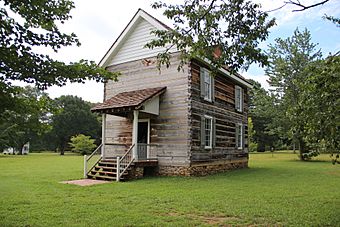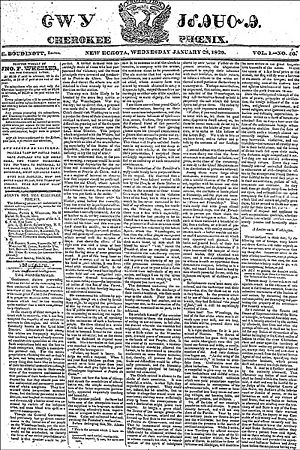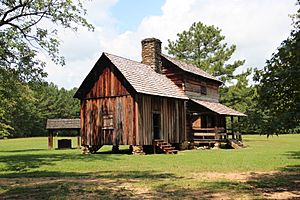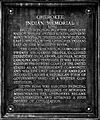New Echota facts for kids
|
New Echota
|
|

The New Echota Council House. The building in this photo is a reconstruction of the original Council House.
|
|
| Location | 1211 Chatsworth Hwy. |
|---|---|
| Nearest city | Calhoun, Georgia and Resaca, Georgia |
| Area | 200 acres (81 ha) |
| Built | 1825–1849 |
| Architect | Cherokees |
| Architectural style | Domestic style architecture |
| NRHP reference No. | 70000869 |
Quick facts for kids Significant dates |
|
| Added to NRHP | May 13, 1970 |
| Designated NHLD | November 7, 1973 |
New Echota was once the important capital city of the Cherokee Nation. This was a time when the Cherokee people lived in the Southeastern United States. New Echota served as their capital from 1825 until the late 1830s. This is when the Cherokee were sadly forced to leave their homes.
Today, New Echota is located in Gordon County, in northwest Georgia. It is north of Calhoun and south of Resaca. The site is now a special state park and a historic place. In 1973, it was recognized as a National Historic Landmark District. This means it is a very important place in American history.
The town was built where the Coosawattee and Conasauga rivers meet. These rivers then form the Oostanaula River. Long before the Cherokee, other ancient groups lived here for thousands of years. The Cherokee renamed the area New Echota in 1825. They chose this name to honor their old capital, Chota, which was located in what is now Tennessee.
Contents
The Cherokee Nation's Capital City
Before New Echota became the capital, the Cherokee used a nearby town called Ustanali. They had moved there in 1788 from eastern Tennessee and western South Carolina. This move happened because more and more European-American settlers were moving into their lands.
How New Echota Became Important
In 1777, some Cherokee leaders were killed by white settlers. This happened even though they were meeting peacefully. After this, Little Turkey was chosen as a new chief. The Cherokee leaders decided to move their main council meeting place. They moved it from Chota to Ustanali. Later, they moved it again to New Echota. The name "New Echota" was a way to remember their old capital, Chota.
Many English-speaking people called New Echota "Newtown" or "New Town." These names are still used for the area around the state park today.

By 1819, the Cherokee Nation's government was already meeting in New Echota. On November 12, 1825, they officially made New Echota their capital. The Cherokee had a council and a supreme court to make laws and solve problems. They started building important structures in their new capital.
Buildings in the Capital
The Cherokee built a two-story Council House for their government meetings. They also built a Supreme Court building for their justice system. A very important building was the office for the Cherokee Phoenix newspaper. This was the first newspaper for Native Americans that was printed in their own language.
Elias Boudinot was the main writer and editor. Samuel Worcester, a missionary, helped set up the printing. The newspaper was written in both English and Cherokee. For the Cherokee parts, they used a new writing system called a syllabary. This amazing system was created by Sequoyah in 1820. Besides these public buildings, people also built homes, stores, and a ferry.
Most of the year, New Echota was a quiet town. But when the council met, it became a lively place. Hundreds of Cherokee people would come to town. They arrived on foot, on horseback, or in fancy carriages. These meetings were big social events for everyone.

The Forced Removal of the Cherokee
In 1832, the U.S. Congress passed the Indian Removal Act. This law allowed the state of Georgia to claim Cherokee land. Georgia then held a lottery to give this land to white settlers. However, the Cherokee Nation had never agreed to give up their land.
Conflict Over Land Rights
The U.S. Supreme Court actually said that the Cherokee had the right to their land. But Georgia kept pushing for them to leave. Over the next six years, the Georgia Guard forced Cherokee people off their properties. By 1834, New Echota started to become empty. The Cherokee council had to move its meetings to Red Clay, in what is now Tennessee. The United States government offered the Cherokee land west of the Mississippi River if they would leave Georgia.
The Treaty of New Echota
On December 29, 1835, a small group of Cherokee leaders signed the Treaty of New Echota. This group, known as the Treaty Party, did not represent most of the Cherokee people. They signed the treaty in the home of Elias Boudinot. Leaders like Major Ridge and John Ridge were among the signers. They believed that signing the treaty was the only way to save some rights for their people.
The treaty meant the Cherokee would give up their remaining lands in the Southeast. In return, they would get new lands west of the Mississippi River. They were promised their own government in this new territory. John Ross, the main chief, and most of the Cherokee people strongly disagreed with this treaty. But the U.S. Senate approved it anyway. This led to the U.S. government forcing most of the Cherokee out of their homes.
The Trail of Tears
In 1838, the U.S. Army, led by General Winfield Scott, began the forced removal of the Cherokee from Georgia. A temporary camp, called Fort Wool, was set up at New Echota. Cherokee people from Gordon and Pickens counties were held here. They waited until it was time for them to be moved. This forced journey became known as the Trail of Tears. It was a very sad and difficult time for the Cherokee people.
New Echota Historic Site Today
After the Cherokee were forced to leave in 1838, their capital city was left empty for over 100 years. Many buildings fell apart, but some houses were still used. The house of Samuel Worcester, a missionary, was one of the most notable remaining structures.
Discovering the Past
From 1930 to 1950, the site was recognized as the New Echota Marker National Memorial. In 1954, archaeologists began digging at New Echota. They found evidence of the Cherokee settlement and even older cultures. They found a Spanish coin from 1802, pottery, household items, and many other artifacts. They also discovered some of the metal type used to print the Cherokee Phoenix newspaper.
Rebuilding the Capital
Because of these exciting discoveries, Georgia decided to rebuild New Echota as a state park in 1957. They reconstructed important buildings like the Council House and the Supreme Court. They also rebuilt the printer shop for the Cherokee Phoenix. Visitors can see examples of a common Cherokee cabin and a middle-class Cherokee home.
Vann's Tavern, which belonged to Chief James Vann, was also restored. The original tavern at New Echota was gone, so they moved another one of Chief Vann's taverns from a different county to the park. The Worcester House was also carefully restored to look as it did in the 1800s. All these buildings together form an open-air museum.
The New Echota Historical Park opened to the public in 1962. Inside the Cherokee Phoenix office, you can see some of the original printing type. Later, some of this type was moved to a museum and research center at the park.
Exploring the Park
The Newtown Trail is a 1.2-mile path that visitors can walk. It leads to Town Creek, which was a camping area for many Cherokee when the council was meeting. In 1973, the Georgia Department of Natural Resources took over the park. They continue to care for and maintain this important historic site. New Echota was named a National Historic Landmark in 1973, which is the highest honor for historic places in the U.S.
Images for kids
-
This monument at New Echota honors the Cherokee people who died during the Trail of Tears.
See also







